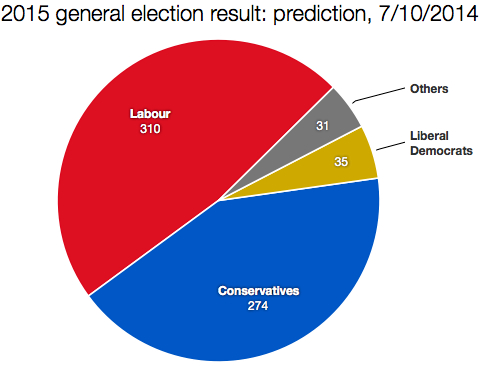Election forecasts
Seven months to go
It’s that point in the calendar where I offer my latest prediction of the election result.
Precisely seven months away from polling day, I’m once again forecasting a hung parliament, as I have done ever since this blog began. But as usual I’ve slightly revised my totals, and have for the first time increased the number of seats won by parties other than the big three.
 I’m now suggesting Labour will win 310 seats, up 52 on the 2010 result (this total includes Corby, which Labour won from the Tories in the 2012 by-election). The Tories will win 274, down 32 (this total doesn’t include the Speaker).
I’m now suggesting Labour will win 310 seats, up 52 on the 2010 result (this total includes Corby, which Labour won from the Tories in the 2012 by-election). The Tories will win 274, down 32 (this total doesn’t include the Speaker).
The Liberal Democrats will win 35, down 22. Others, including the Speaker and George Galloway, who I’ve assumed will hold his 2012 by-election gain in Bradford West, will total 31.
This prediction contains a few small changes on the one in September. Labour’s total is up two and the SNP is up one: both are at the Lib Dems’ expense. I seem to find it hard to give up my habit of revising the Lib Dems’ total successively downwards. But as I said in September, with each month that passes without the party managing to climb back above 10% in the polls, so the number of seats they stand to lose increases.
I’m continuing to hold off awarding any gains to Ukip until they actually win a by-election. I’m waiting to see how big a majority the party is able to achieve in Clacton, and also whether it can do the same again in Rochester & Strood. Both of these contests ought to have taken place by the time I come to do my next prediction in a month’s time.
If you’re minded to believe Ukip will not only win both seats at the by-elections but also at the general election, simply knock two off the Tories’ total in the chart above.
I’ve handed the SNP one gain from the Liberal Democrats, in Gordon. The party is now being tipped to seize seats off Labour as well, though I’m waiting to see a bit more evidence of a swing in some key Scottish constituencies before saying this will definitely happen. But even if the SNP did win, say, five seats off Labour, that wouldn’t affect the overall outcome of my prediction. Labour would still be the largest party in a hung parliament, and would need to agree a coalition if it wanted to form a majority government.
On my forecast, a Labour-Lib Dem coalition would total 345, 19 above the number needed for an absolute majority in parliament. A Tory-Lib Dem coalition would total 309: 17 below the magic figure of 326.
Here’s how I calculated this month’s prediction:
Labour’s 52 gains
From the Lib Dems: Norwich South, Bradford East, Brent Central, Burnley, Manchester Withington, Dunbartonshire East, Birmingham Yardley, Edinburgh West, Hornsey & Wood Green, Cardiff Central, Redcar, Caithness Sutherland & Easter Ross and Cambridge (total = 13)
From the Tories: Warwickshire North, Hendon, Cardiff North, Sherwood, Stockton South, Lancaster & Fleetwood, Broxtowe, Amber Valley, Wolverhampton South West, Waveney, Carlisle, Morecambe & Lunesdale, Weaver Vale, Lincoln, Plymouth Sutton & Devonport, Stroud, Brighton Kemptown, Bedford, Dewsbury, Warrington South, Pudsey, Enfield North, Hove, Northampton North, Brentford & Isleworth, Hastings & Rye, Halesowen & Rowley Regis, Nuneaton, Ipswich, Blackpool North & Cleveleys, Bury North, Gloucester, Wirral West, Croydon Central, Harrow East, Ealing Central & Acton, Norwich North, Dudley South and Watford (total = 39).
The Tories’ eight gains:
From the Lib Dems: Solihull, Dorset Mid & Poole North, Wells, St Austell & Newquay, Somerton & Frome, Chippenham, Berwick-upon-Tweed and Cornwall North.
The SNP’s one gain:
From the Lib Dems: Gordon.
Discussion